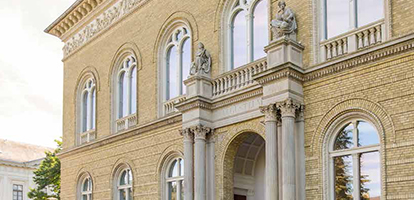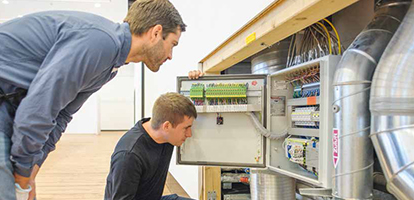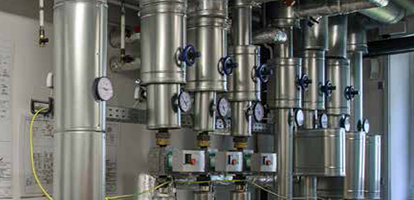



Old works of art require a stable room climate. To optimally maintain them, the correct temperature and humidity must be fastidiously observed. This applies in particular when temporary exhibits are displayed with loaned pieces, because no one will provide art works if they are not assured that they will be returned in the original state. Therefore, in the course of substantial modernization work at the Oldenburg Augusteum, an indoor air system including individual room monitoring was installed, controlled using the WAGO-I/O-SYSTEM 750. This automated solution guarantees optimal conditions and additionally helps with energy savings. Narrow spatial relationships and monument protection requirements provided challenges for the planners.
The Augusteum is located in the center of Oldenburg, a few steps removed from the palace. The building, constructed in 1867, was the first art museum in the city. A lavishly furnished gallery building, it was designed for the Grand Duke’s collection of paintings. Today, it is part of the State Museum for Art and Cultural History in Oldenburg and houses the “Gallery of the Old Masters” with outstanding works from the Italian, Dutch, French, and German artists of the 15th to the 18th centuries. In addition, the Augusteum has space for temporary exhibits in the upper story. Both old masterpieces and the owners of the valuable works loaned for the special exhibits demand good climate conditions in the exhibition spaces. The ventilation and air conditioning technology must, therefore, be absolutely up to date.
Automation Ensures Stable Conditions
Previously, stationary humidifiers served to make the dry furnace air more palatable for the works of art. Now, the Augusteum relies on an automated solution that satisfies international museum standards and protects the exhibited art works. The necessary technology was installed over the course of comprehensive modernization work, and has functioned without fault since the re-opening of the museum in December 2015. Nossol Automatisation GmbH was selected by the state museum to install the automation systems along with designers from the engineering firm Ahrens GmbH. They had to accommodate specific conditions guaranteeing the requirements for temperature, humidity, and noise level, which are based on guidelines for HVAC systems developed by the Association of Mechanical and Electrical Engineers in 2011. The margin of error is quite low. Specifically, the room temperature should average 20 degrees Celsius. A maximum hourly deviation of one degree, a maximum short-term deviation of two degrees, and a maximum long-term deviation of five degrees are allowed. The relative humidity must remain at 50 percent. In this case, maximum deviations of 2.5% per hour and 5% per day are permissible. The specification for sound pressure level permits a maximum of 45 decibels. The designers assumed an average number of visitors to be 70 persons per day.
Central HVAC System Creates the Desired Conditions
To fulfill these requirements, and to guarantee a hygienic, pre-conditioned proportion of external air, a central HVAC system was installed in the basement. In addition, the exhibit rooms were decoupled from the open stair case by pairs of self-closing doors, forming air locks. The HVAC system has an output of up to 2400 m³ per hour and provides the functions of heating, cooling, dehumidifying, and air circulation. It is equipped with a high efficiency rotating heat exchanger which has a heat recovery factor of around 75% in heating operation. The air humidity is carried out by a separate steam generator in a downstream humidifying chamber. The air is then transported via the building’s primary duct system into the intermediate floor area between the ground floor and upper story, and from there via air ducts into the exhibit rooms.
Using Building Technology from WAGO
The new ICA system from Nossol Automatisation was equipped with the modular I/O-SYSTEM 750 from WAGO. Nine subdistributors are used in the Augusteum in addition to the information node, which is equipped with a touch panel. They communicate with one another via an ETHERNET network per Modbus/TCP. “By using the open source communication standard, the WAGO controllers can be easily and efficiently connected to one another. Even configuration is no problem due to the user-friendly software,” agree Arne Meyer and Lukas Vorwerk from Nossol Automatisation, which was responsible for the programming.
Space Limitations and Monument Protection as Challenges
Decentralized air treatment modules (ATMs) were also installed in the exhibit rooms. These cover cooling loads and enable individual room monitoring. The ATMs function exclusively in air circulation mode and generate around 350 to 400 m³ of air per hour. They heat, cool, dehumidify, and transport the air in the rooms. The accommodation of the devices and the necessary supply routes were anything but easy. After all, the exhibit rooms are accessible for visitors. The HVAC technology should not distract from the exhibits and should be as close to invisible as possible. Locating the technology under the ceilings was not practical from maintenance or operational stand points, due to their height. Therefore, the technology had to be concealed in the walls. Because the Augusteum is under monument protection, any changes were highly restricted. Therefore, the building was provided with false walls, which provided 40 cm of space. Which comes out to … not much. It is thus good that WAGO products require little space. “Since the PLC already has two integrated ETHERNET interfaces and a switch, we could omit additional infrastructure elements,” according to Stefan Behrens from Ahrens. “When there’s not much space, that is worth its weight in gold.”
Significantly Increased Energy Efficiency
Even though the main focus was on air quality, a nice side effect of the modernization is a substantial improvement in energy efficiency. Contributors to greater efficiency include the new building technology, a hydraulic balance, which was installed at the same time, and the replacement of the the heating unit's valves.
Text: Stephan Lampe, WAGO
Photo: Till Werhan, Bildschoen